Management Accounting for Financial Problem Solving and Planning
VerifiedAdded on 2024/05/17
|21
|3410
|305
Report
AI Summary
This report provides a comprehensive overview of management accounting principles and their application in resolving financial problems and achieving sustainable success. It begins by defining management accounting and its various systems, including financial accounting, cost accounting, and tax accounting. The report then explores different methods of reporting management accounting information, such as income statements, cost of goods sold reports, and cash flow statements. It delves into cost computation, distinguishing between direct and indirect costs, variable and fixed costs, and relevant and irrelevant costs, with calculations based on absorption and marginal costing. The report also examines the advantages and disadvantages of various planning tools, including incremental budgets, zero-based budgets, and cash budgets, and applies these tools in a practical cash budget scenario, identifying percentage deviations. Finally, it discusses how management accounting can be adapted to resolve financial problems and lead an organization to sustainable success, emphasizing the integration of management accounting systems and reporting within the organization.
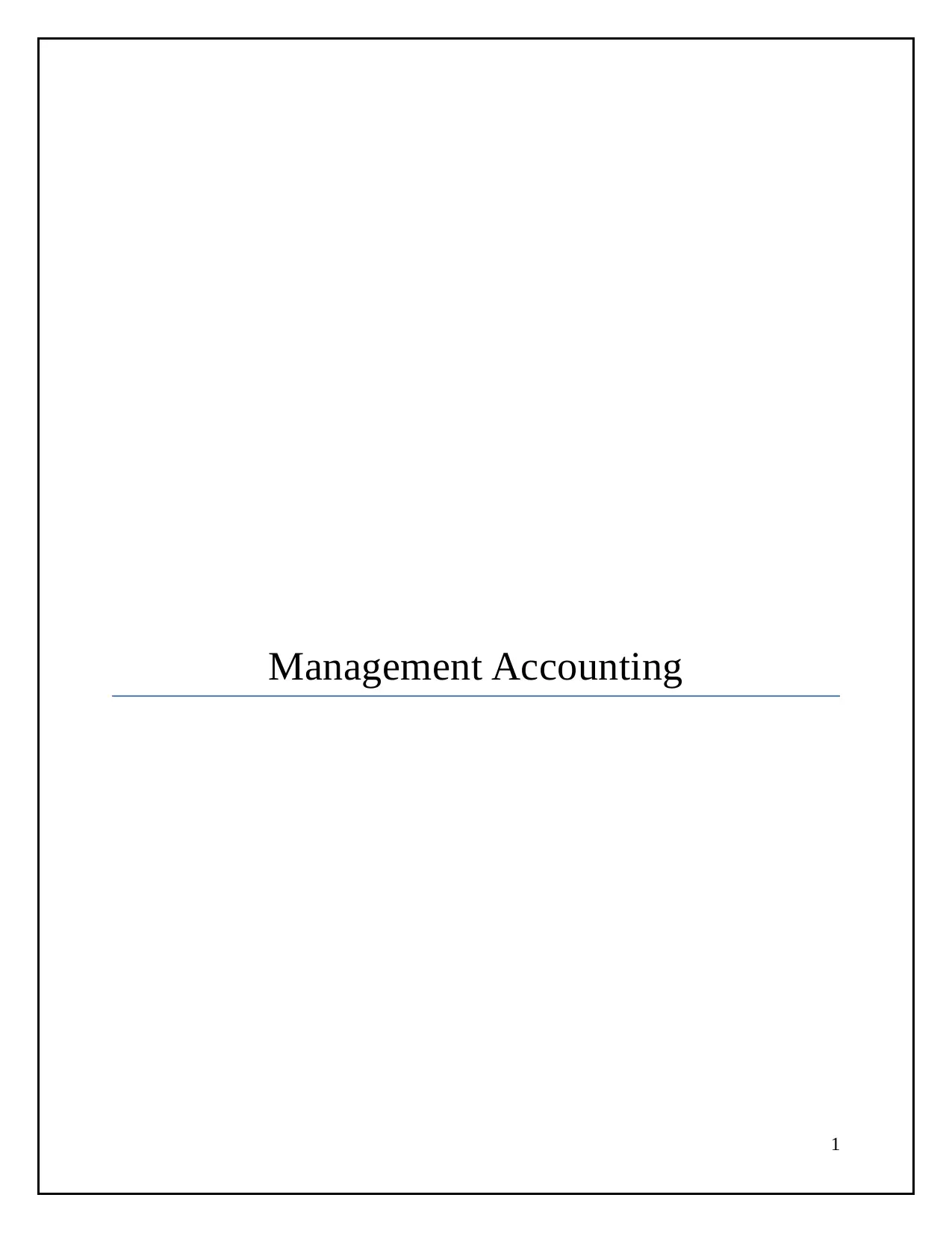
Management Accounting
1
1
Paraphrase This Document
Need a fresh take? Get an instant paraphrase of this document with our AI Paraphraser
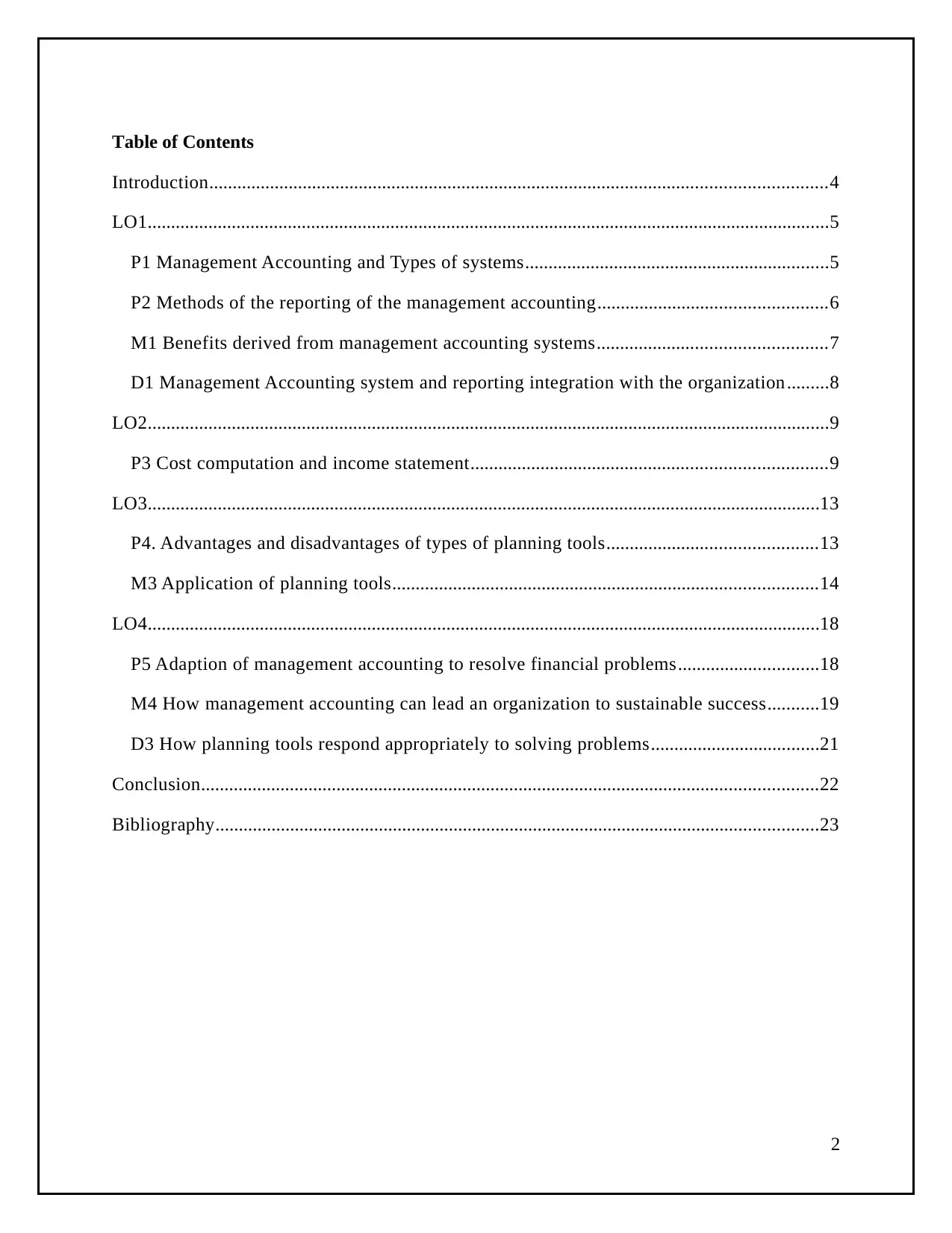
Table of Contents
Introduction....................................................................................................................................4
LO1..................................................................................................................................................5
P1 Management Accounting and Types of systems.................................................................5
P2 Methods of the reporting of the management accounting.................................................6
M1 Benefits derived from management accounting systems.................................................7
D1 Management Accounting system and reporting integration with the organization.........8
LO2..................................................................................................................................................9
P3 Cost computation and income statement............................................................................9
LO3................................................................................................................................................13
P4. Advantages and disadvantages of types of planning tools.............................................13
M3 Application of planning tools...........................................................................................14
LO4................................................................................................................................................18
P5 Adaption of management accounting to resolve financial problems..............................18
M4 How management accounting can lead an organization to sustainable success...........19
D3 How planning tools respond appropriately to solving problems....................................21
Conclusion....................................................................................................................................22
Bibliography.................................................................................................................................23
2
Introduction....................................................................................................................................4
LO1..................................................................................................................................................5
P1 Management Accounting and Types of systems.................................................................5
P2 Methods of the reporting of the management accounting.................................................6
M1 Benefits derived from management accounting systems.................................................7
D1 Management Accounting system and reporting integration with the organization.........8
LO2..................................................................................................................................................9
P3 Cost computation and income statement............................................................................9
LO3................................................................................................................................................13
P4. Advantages and disadvantages of types of planning tools.............................................13
M3 Application of planning tools...........................................................................................14
LO4................................................................................................................................................18
P5 Adaption of management accounting to resolve financial problems..............................18
M4 How management accounting can lead an organization to sustainable success...........19
D3 How planning tools respond appropriately to solving problems....................................21
Conclusion....................................................................................................................................22
Bibliography.................................................................................................................................23
2
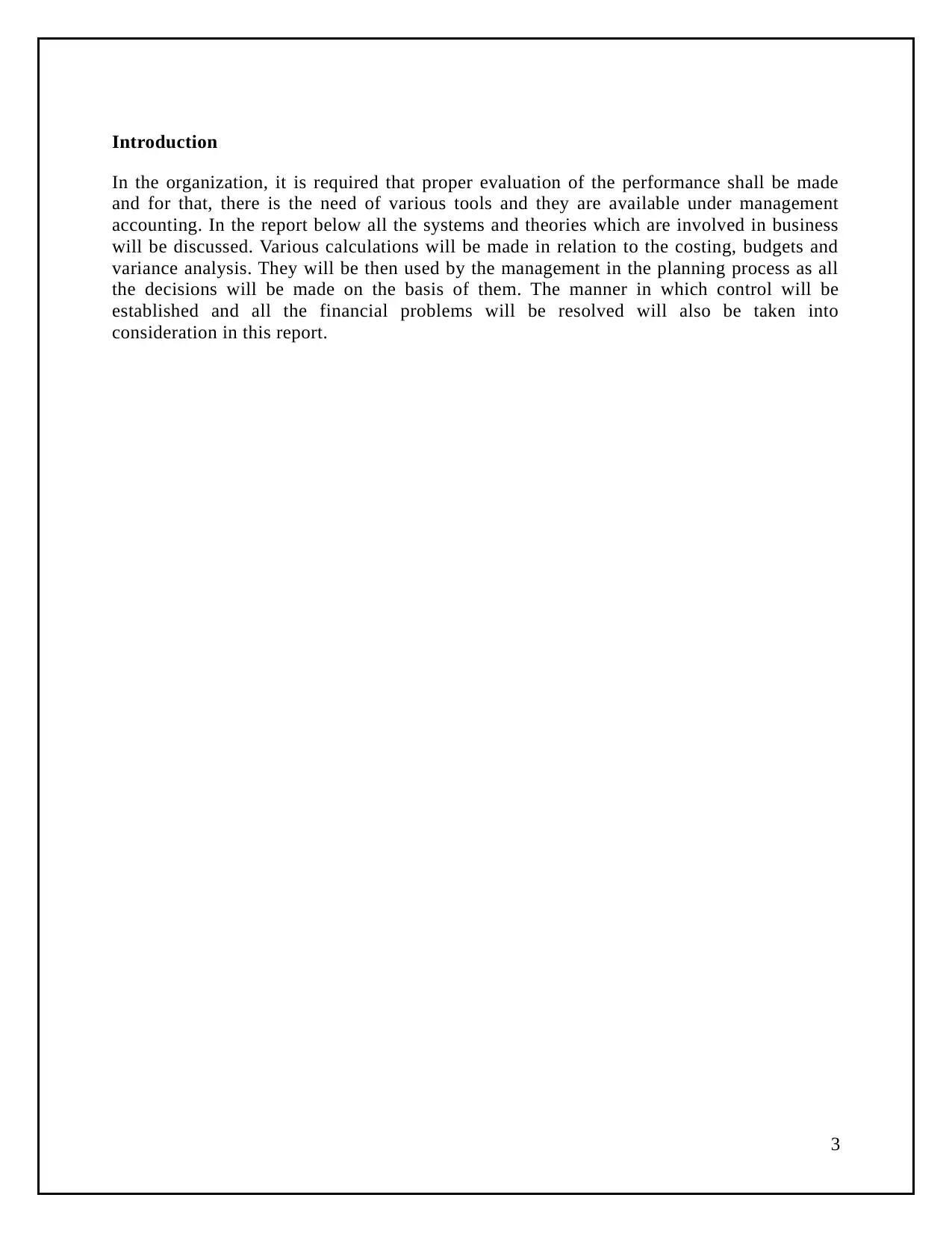
Introduction
In the organization, it is required that proper evaluation of the performance shall be made
and for that, there is the need of various tools and they are available under management
accounting. In the report below all the systems and theories which are involved in business
will be discussed. Various calculations will be made in relation to the costing, budgets and
variance analysis. They will be then used by the management in the planning process as all
the decisions will be made on the basis of them. The manner in which control will be
established and all the financial problems will be resolved will also be taken into
consideration in this report.
3
In the organization, it is required that proper evaluation of the performance shall be made
and for that, there is the need of various tools and they are available under management
accounting. In the report below all the systems and theories which are involved in business
will be discussed. Various calculations will be made in relation to the costing, budgets and
variance analysis. They will be then used by the management in the planning process as all
the decisions will be made on the basis of them. The manner in which control will be
established and all the financial problems will be resolved will also be taken into
consideration in this report.
3
⊘ This is a preview!⊘
Do you want full access?
Subscribe today to unlock all pages.

Trusted by 1+ million students worldwide
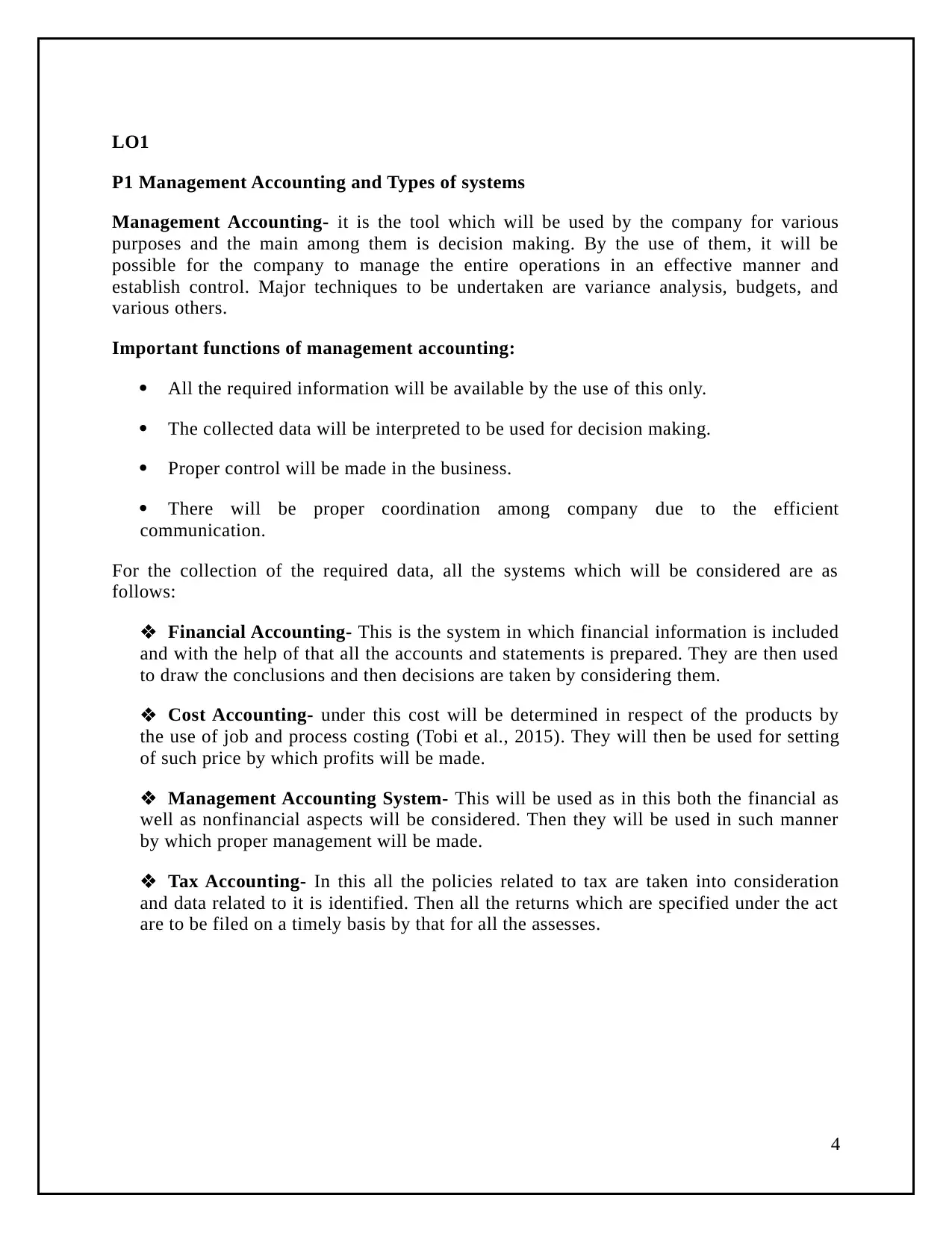
LO1
P1 Management Accounting and Types of systems
Management Accounting- it is the tool which will be used by the company for various
purposes and the main among them is decision making. By the use of them, it will be
possible for the company to manage the entire operations in an effective manner and
establish control. Major techniques to be undertaken are variance analysis, budgets, and
various others.
Important functions of management accounting:
All the required information will be available by the use of this only.
The collected data will be interpreted to be used for decision making.
Proper control will be made in the business.
There will be proper coordination among company due to the efficient
communication.
For the collection of the required data, all the systems which will be considered are as
follows:
Financial Accounting- This is the system in which financial information is included
and with the help of that all the accounts and statements is prepared. They are then used
to draw the conclusions and then decisions are taken by considering them.
Cost Accounting- under this cost will be determined in respect of the products by
the use of job and process costing (Tobi et al., 2015). They will then be used for setting
of such price by which profits will be made.
Management Accounting System- This will be used as in this both the financial as
well as nonfinancial aspects will be considered. Then they will be used in such manner
by which proper management will be made.
Tax Accounting- In this all the policies related to tax are taken into consideration
and data related to it is identified. Then all the returns which are specified under the act
are to be filed on a timely basis by that for all the assesses.
4
P1 Management Accounting and Types of systems
Management Accounting- it is the tool which will be used by the company for various
purposes and the main among them is decision making. By the use of them, it will be
possible for the company to manage the entire operations in an effective manner and
establish control. Major techniques to be undertaken are variance analysis, budgets, and
various others.
Important functions of management accounting:
All the required information will be available by the use of this only.
The collected data will be interpreted to be used for decision making.
Proper control will be made in the business.
There will be proper coordination among company due to the efficient
communication.
For the collection of the required data, all the systems which will be considered are as
follows:
Financial Accounting- This is the system in which financial information is included
and with the help of that all the accounts and statements is prepared. They are then used
to draw the conclusions and then decisions are taken by considering them.
Cost Accounting- under this cost will be determined in respect of the products by
the use of job and process costing (Tobi et al., 2015). They will then be used for setting
of such price by which profits will be made.
Management Accounting System- This will be used as in this both the financial as
well as nonfinancial aspects will be considered. Then they will be used in such manner
by which proper management will be made.
Tax Accounting- In this all the policies related to tax are taken into consideration
and data related to it is identified. Then all the returns which are specified under the act
are to be filed on a timely basis by that for all the assesses.
4
Paraphrase This Document
Need a fresh take? Get an instant paraphrase of this document with our AI Paraphraser
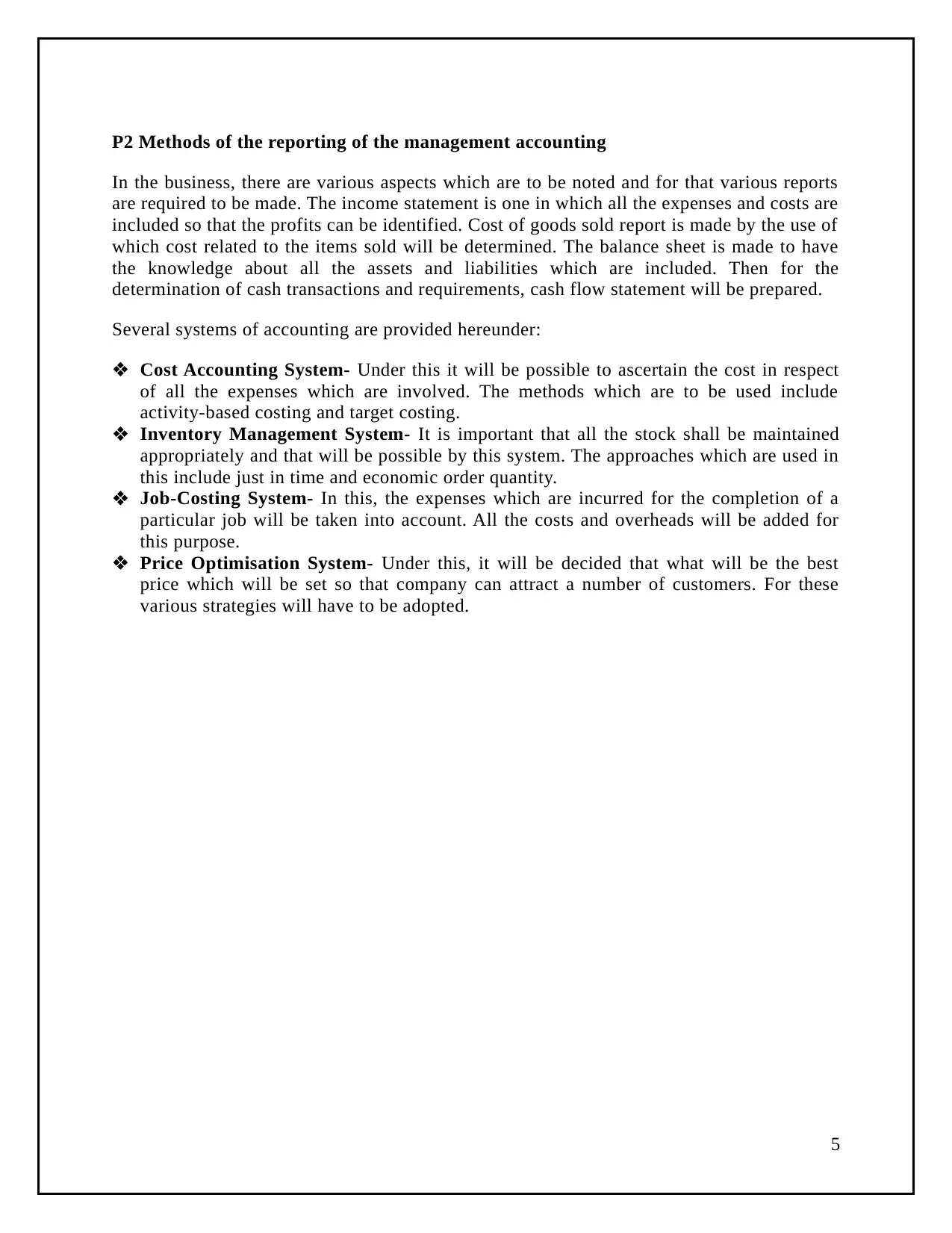
P2 Methods of the reporting of the management accounting
In the business, there are various aspects which are to be noted and for that various reports
are required to be made. The income statement is one in which all the expenses and costs are
included so that the profits can be identified. Cost of goods sold report is made by the use of
which cost related to the items sold will be determined. The balance sheet is made to have
the knowledge about all the assets and liabilities which are included. Then for the
determination of cash transactions and requirements, cash flow statement will be prepared.
Several systems of accounting are provided hereunder:
Cost Accounting System- Under this it will be possible to ascertain the cost in respect
of all the expenses which are involved. The methods which are to be used include
activity-based costing and target costing.
Inventory Management System- It is important that all the stock shall be maintained
appropriately and that will be possible by this system. The approaches which are used in
this include just in time and economic order quantity.
Job-Costing System- In this, the expenses which are incurred for the completion of a
particular job will be taken into account. All the costs and overheads will be added for
this purpose.
Price Optimisation System- Under this, it will be decided that what will be the best
price which will be set so that company can attract a number of customers. For these
various strategies will have to be adopted.
5
In the business, there are various aspects which are to be noted and for that various reports
are required to be made. The income statement is one in which all the expenses and costs are
included so that the profits can be identified. Cost of goods sold report is made by the use of
which cost related to the items sold will be determined. The balance sheet is made to have
the knowledge about all the assets and liabilities which are included. Then for the
determination of cash transactions and requirements, cash flow statement will be prepared.
Several systems of accounting are provided hereunder:
Cost Accounting System- Under this it will be possible to ascertain the cost in respect
of all the expenses which are involved. The methods which are to be used include
activity-based costing and target costing.
Inventory Management System- It is important that all the stock shall be maintained
appropriately and that will be possible by this system. The approaches which are used in
this include just in time and economic order quantity.
Job-Costing System- In this, the expenses which are incurred for the completion of a
particular job will be taken into account. All the costs and overheads will be added for
this purpose.
Price Optimisation System- Under this, it will be decided that what will be the best
price which will be set so that company can attract a number of customers. For these
various strategies will have to be adopted.
5
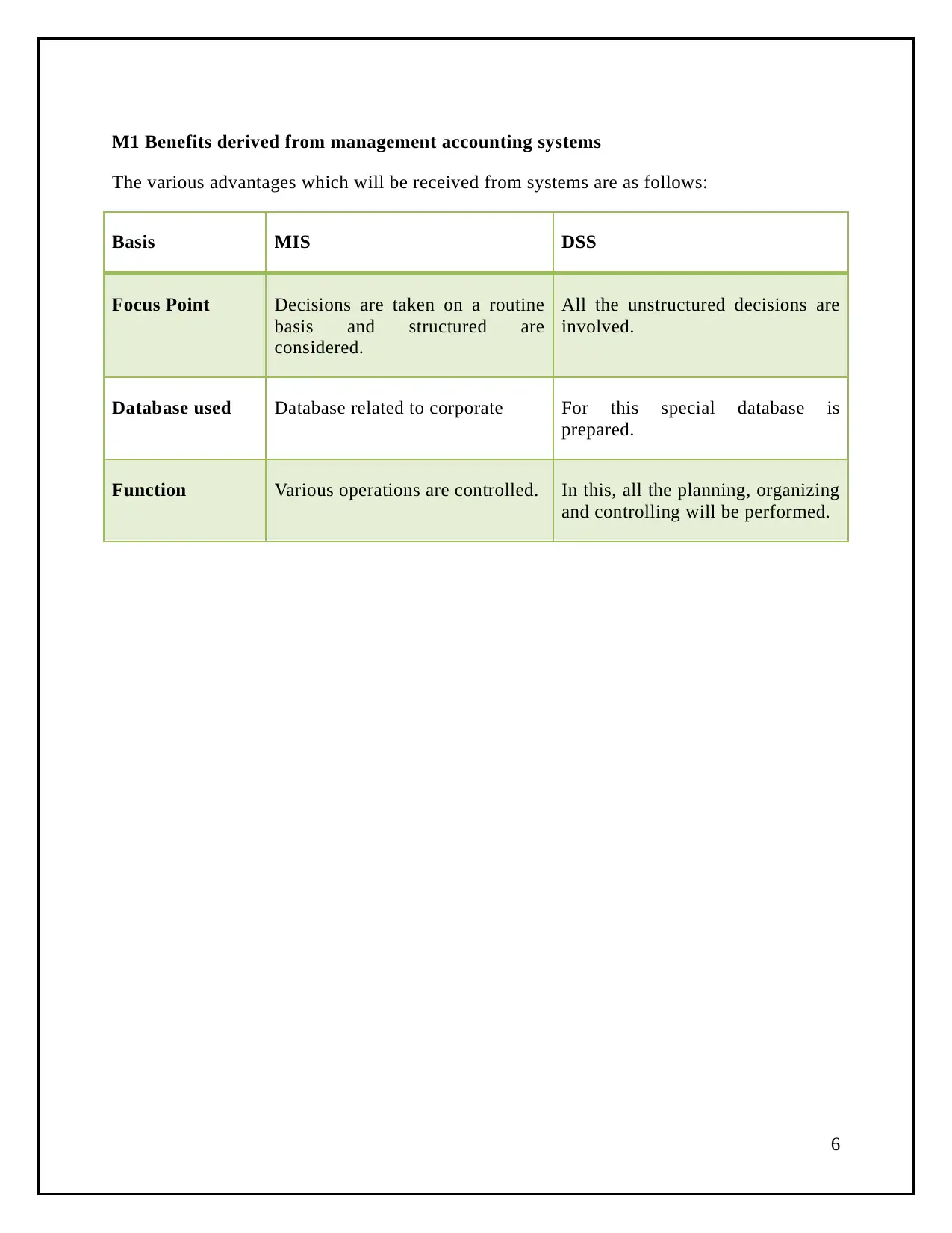
M1 Benefits derived from management accounting systems
The various advantages which will be received from systems are as follows:
Basis MIS DSS
Focus Point Decisions are taken on a routine
basis and structured are
considered.
All the unstructured decisions are
involved.
Database used Database related to corporate For this special database is
prepared.
Function Various operations are controlled. In this, all the planning, organizing
and controlling will be performed.
6
The various advantages which will be received from systems are as follows:
Basis MIS DSS
Focus Point Decisions are taken on a routine
basis and structured are
considered.
All the unstructured decisions are
involved.
Database used Database related to corporate For this special database is
prepared.
Function Various operations are controlled. In this, all the planning, organizing
and controlling will be performed.
6
⊘ This is a preview!⊘
Do you want full access?
Subscribe today to unlock all pages.

Trusted by 1+ million students worldwide
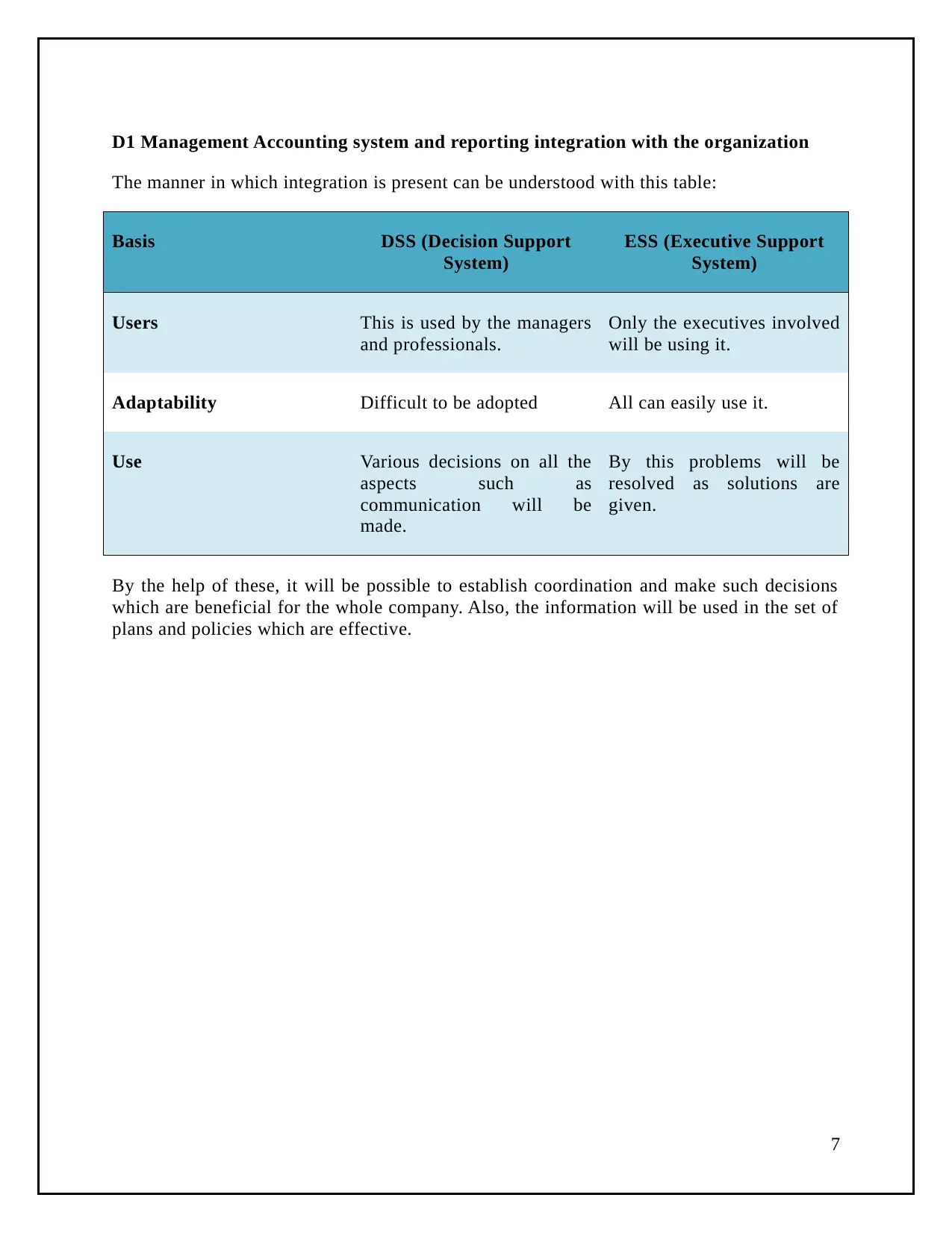
D1 Management Accounting system and reporting integration with the organization
The manner in which integration is present can be understood with this table:
Basis DSS (Decision Support
System)
ESS (Executive Support
System)
Users This is used by the managers
and professionals.
Only the executives involved
will be using it.
Adaptability Difficult to be adopted All can easily use it.
Use Various decisions on all the
aspects such as
communication will be
made.
By this problems will be
resolved as solutions are
given.
By the help of these, it will be possible to establish coordination and make such decisions
which are beneficial for the whole company. Also, the information will be used in the set of
plans and policies which are effective.
7
The manner in which integration is present can be understood with this table:
Basis DSS (Decision Support
System)
ESS (Executive Support
System)
Users This is used by the managers
and professionals.
Only the executives involved
will be using it.
Adaptability Difficult to be adopted All can easily use it.
Use Various decisions on all the
aspects such as
communication will be
made.
By this problems will be
resolved as solutions are
given.
By the help of these, it will be possible to establish coordination and make such decisions
which are beneficial for the whole company. Also, the information will be used in the set of
plans and policies which are effective.
7
Paraphrase This Document
Need a fresh take? Get an instant paraphrase of this document with our AI Paraphraser
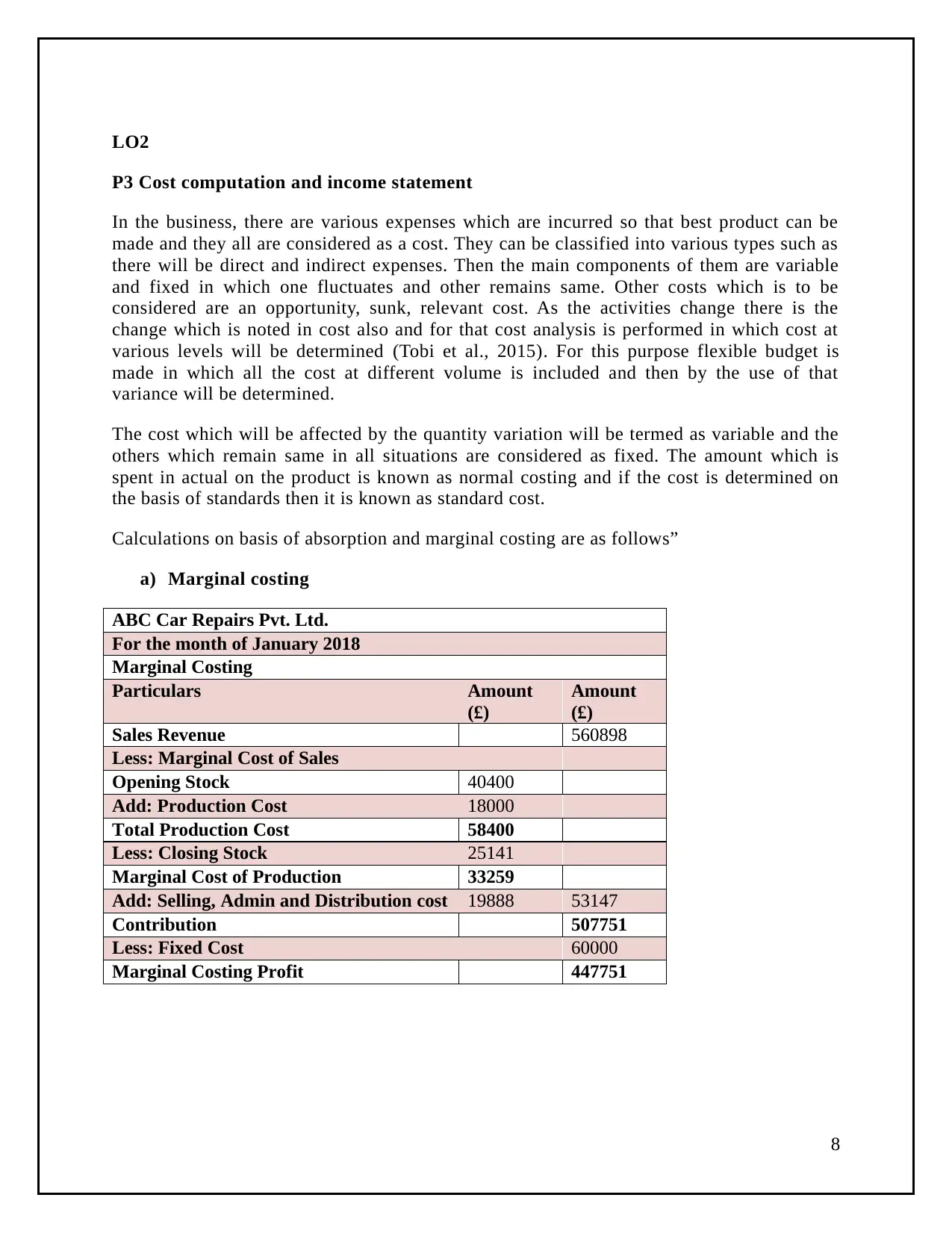
LO2
P3 Cost computation and income statement
In the business, there are various expenses which are incurred so that best product can be
made and they all are considered as a cost. They can be classified into various types such as
there will be direct and indirect expenses. Then the main components of them are variable
and fixed in which one fluctuates and other remains same. Other costs which is to be
considered are an opportunity, sunk, relevant cost. As the activities change there is the
change which is noted in cost also and for that cost analysis is performed in which cost at
various levels will be determined (Tobi et al., 2015). For this purpose flexible budget is
made in which all the cost at different volume is included and then by the use of that
variance will be determined.
The cost which will be affected by the quantity variation will be termed as variable and the
others which remain same in all situations are considered as fixed. The amount which is
spent in actual on the product is known as normal costing and if the cost is determined on
the basis of standards then it is known as standard cost.
Calculations on basis of absorption and marginal costing are as follows”
a) Marginal costing
ABC Car Repairs Pvt. Ltd.
For the month of January 2018
Marginal Costing
Particulars Amount
(£)
Amount
(£)
Sales Revenue 560898
Less: Marginal Cost of Sales
Opening Stock 40400
Add: Production Cost 18000
Total Production Cost 58400
Less: Closing Stock 25141
Marginal Cost of Production 33259
Add: Selling, Admin and Distribution cost 19888 53147
Contribution 507751
Less: Fixed Cost 60000
Marginal Costing Profit 447751
8
P3 Cost computation and income statement
In the business, there are various expenses which are incurred so that best product can be
made and they all are considered as a cost. They can be classified into various types such as
there will be direct and indirect expenses. Then the main components of them are variable
and fixed in which one fluctuates and other remains same. Other costs which is to be
considered are an opportunity, sunk, relevant cost. As the activities change there is the
change which is noted in cost also and for that cost analysis is performed in which cost at
various levels will be determined (Tobi et al., 2015). For this purpose flexible budget is
made in which all the cost at different volume is included and then by the use of that
variance will be determined.
The cost which will be affected by the quantity variation will be termed as variable and the
others which remain same in all situations are considered as fixed. The amount which is
spent in actual on the product is known as normal costing and if the cost is determined on
the basis of standards then it is known as standard cost.
Calculations on basis of absorption and marginal costing are as follows”
a) Marginal costing
ABC Car Repairs Pvt. Ltd.
For the month of January 2018
Marginal Costing
Particulars Amount
(£)
Amount
(£)
Sales Revenue 560898
Less: Marginal Cost of Sales
Opening Stock 40400
Add: Production Cost 18000
Total Production Cost 58400
Less: Closing Stock 25141
Marginal Cost of Production 33259
Add: Selling, Admin and Distribution cost 19888 53147
Contribution 507751
Less: Fixed Cost 60000
Marginal Costing Profit 447751
8
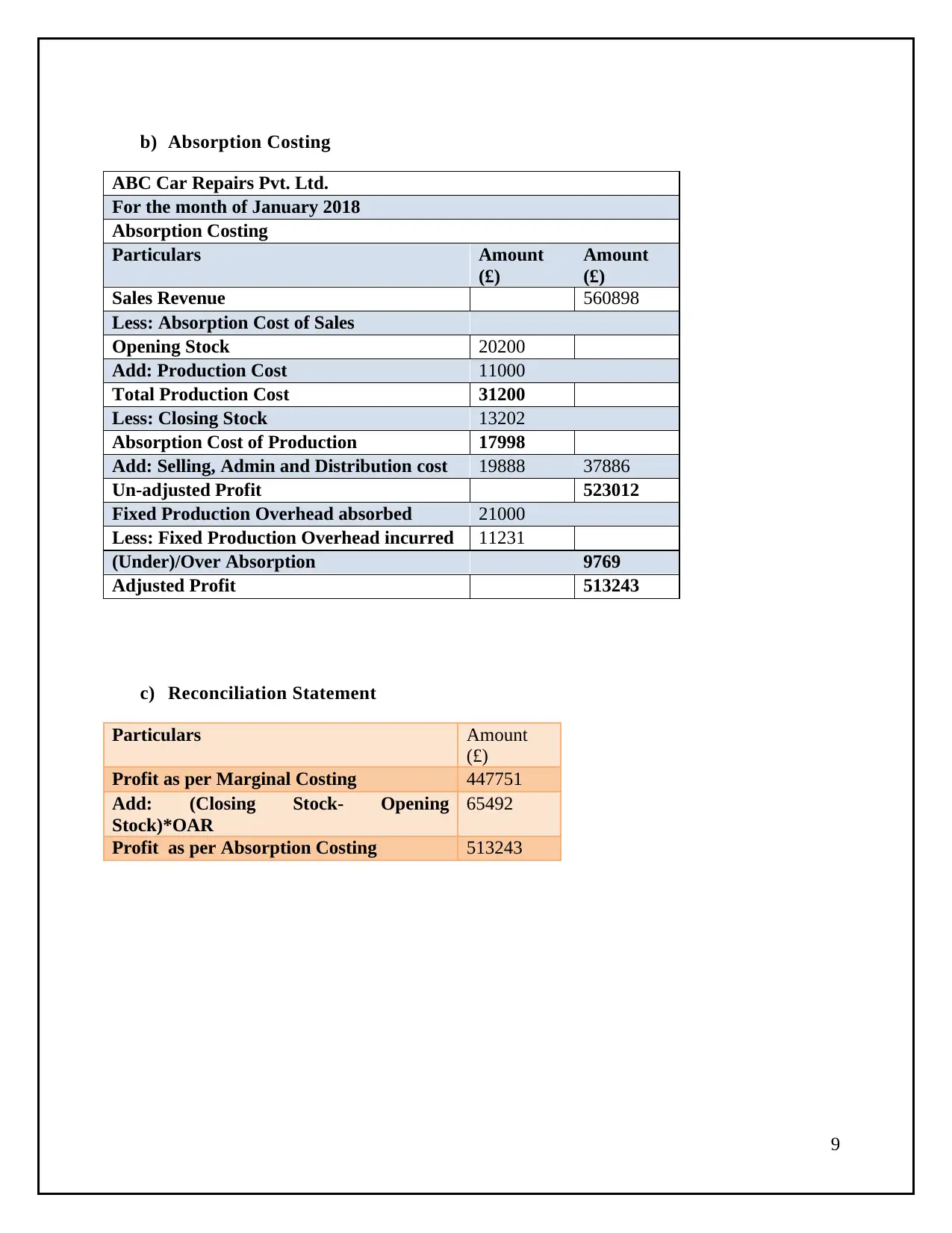
b) Absorption Costing
ABC Car Repairs Pvt. Ltd.
For the month of January 2018
Absorption Costing
Particulars Amount
(£)
Amount
(£)
Sales Revenue 560898
Less: Absorption Cost of Sales
Opening Stock 20200
Add: Production Cost 11000
Total Production Cost 31200
Less: Closing Stock 13202
Absorption Cost of Production 17998
Add: Selling, Admin and Distribution cost 19888 37886
Un-adjusted Profit 523012
Fixed Production Overhead absorbed 21000
Less: Fixed Production Overhead incurred 11231
(Under)/Over Absorption 9769
Adjusted Profit 513243
c) Reconciliation Statement
Particulars Amount
(£)
Profit as per Marginal Costing 447751
Add: (Closing Stock- Opening
Stock)*OAR
65492
Profit as per Absorption Costing 513243
9
ABC Car Repairs Pvt. Ltd.
For the month of January 2018
Absorption Costing
Particulars Amount
(£)
Amount
(£)
Sales Revenue 560898
Less: Absorption Cost of Sales
Opening Stock 20200
Add: Production Cost 11000
Total Production Cost 31200
Less: Closing Stock 13202
Absorption Cost of Production 17998
Add: Selling, Admin and Distribution cost 19888 37886
Un-adjusted Profit 523012
Fixed Production Overhead absorbed 21000
Less: Fixed Production Overhead incurred 11231
(Under)/Over Absorption 9769
Adjusted Profit 513243
c) Reconciliation Statement
Particulars Amount
(£)
Profit as per Marginal Costing 447751
Add: (Closing Stock- Opening
Stock)*OAR
65492
Profit as per Absorption Costing 513243
9
⊘ This is a preview!⊘
Do you want full access?
Subscribe today to unlock all pages.

Trusted by 1+ million students worldwide
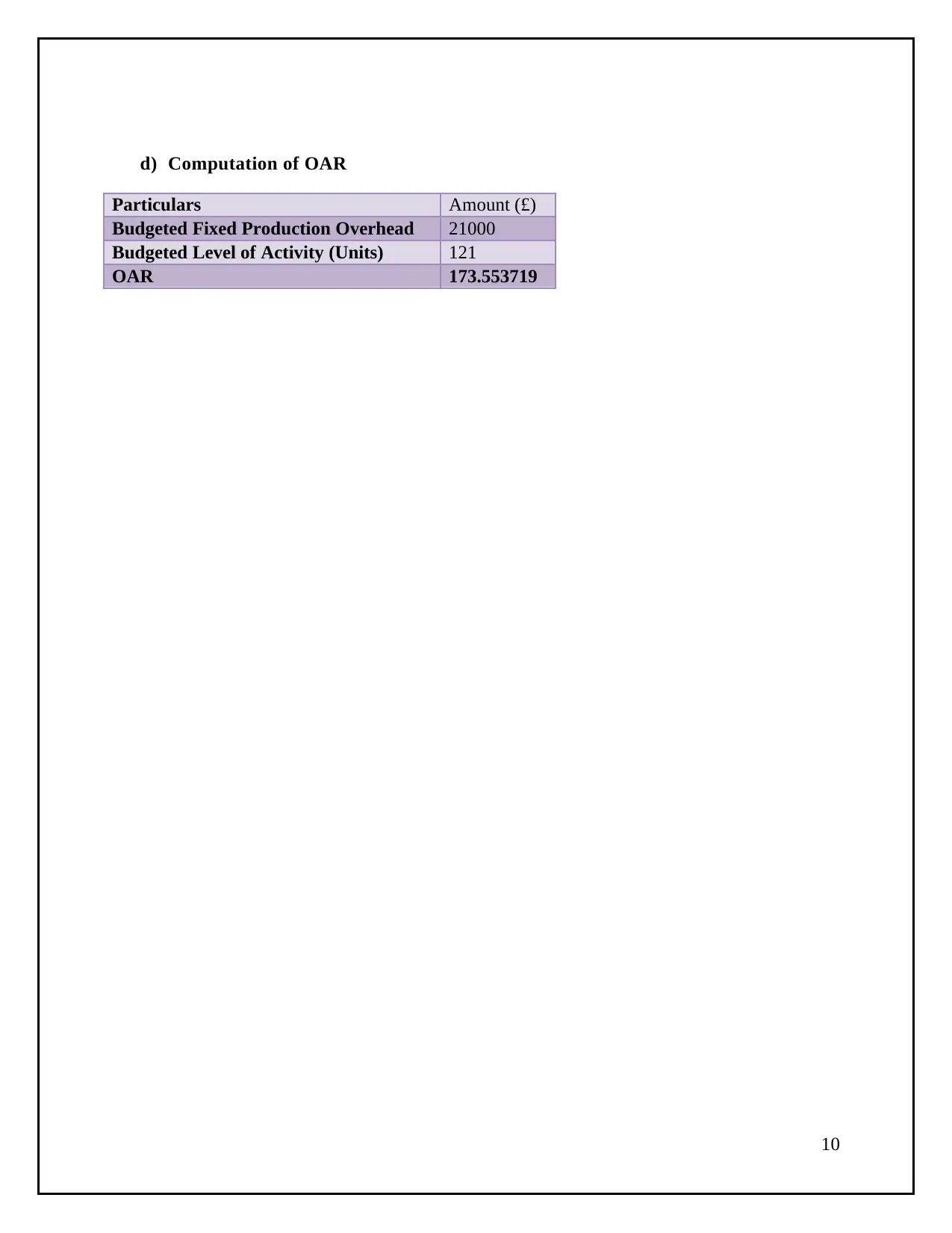
d) Computation of OAR
Particulars Amount (£)
Budgeted Fixed Production Overhead 21000
Budgeted Level of Activity (Units) 121
OAR 173.553719
10
Particulars Amount (£)
Budgeted Fixed Production Overhead 21000
Budgeted Level of Activity (Units) 121
OAR 173.553719
10
Paraphrase This Document
Need a fresh take? Get an instant paraphrase of this document with our AI Paraphraser
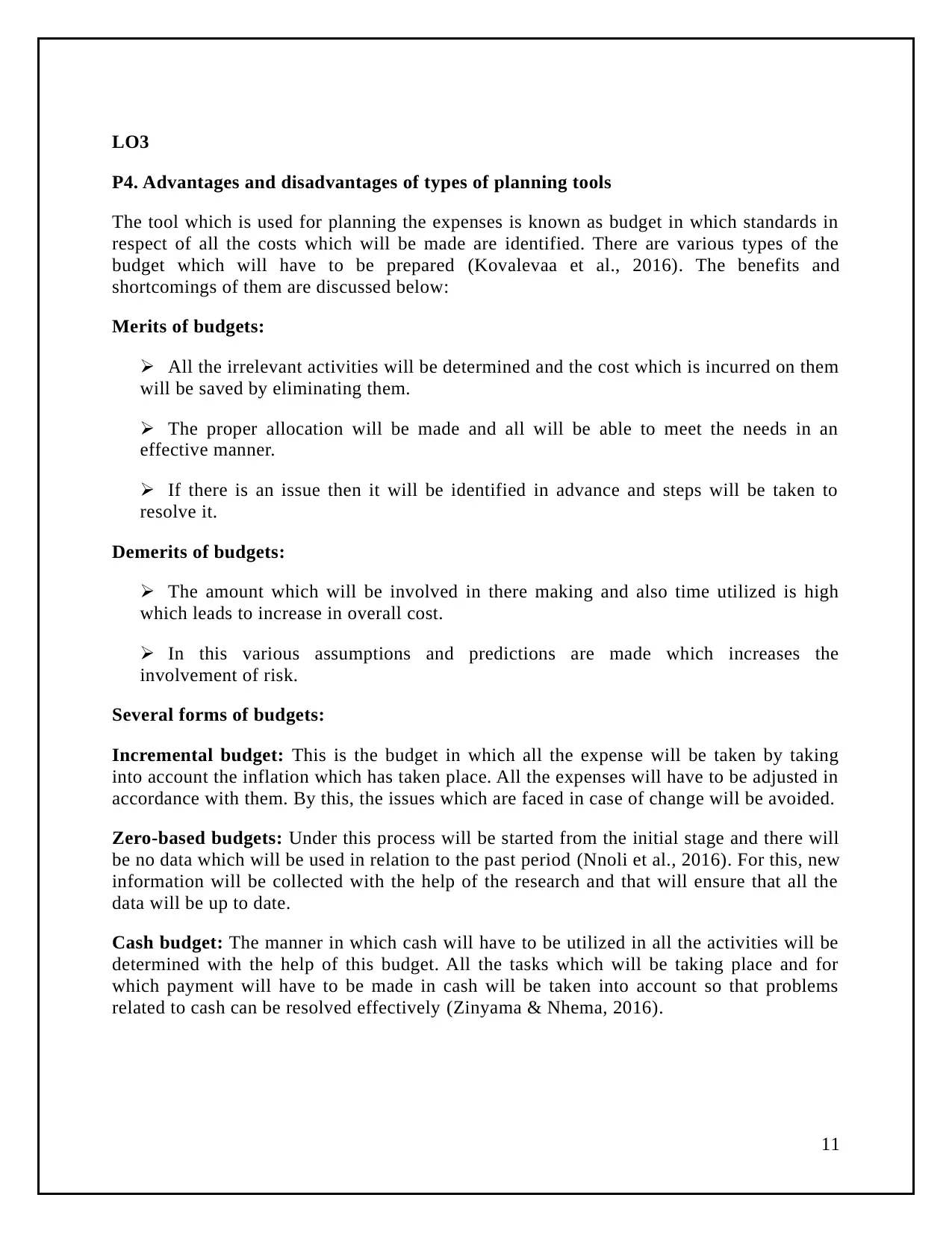
LO3
P4. Advantages and disadvantages of types of planning tools
The tool which is used for planning the expenses is known as budget in which standards in
respect of all the costs which will be made are identified. There are various types of the
budget which will have to be prepared (Kovalevaa et al., 2016). The benefits and
shortcomings of them are discussed below:
Merits of budgets:
All the irrelevant activities will be determined and the cost which is incurred on them
will be saved by eliminating them.
The proper allocation will be made and all will be able to meet the needs in an
effective manner.
If there is an issue then it will be identified in advance and steps will be taken to
resolve it.
Demerits of budgets:
The amount which will be involved in there making and also time utilized is high
which leads to increase in overall cost.
In this various assumptions and predictions are made which increases the
involvement of risk.
Several forms of budgets:
Incremental budget: This is the budget in which all the expense will be taken by taking
into account the inflation which has taken place. All the expenses will have to be adjusted in
accordance with them. By this, the issues which are faced in case of change will be avoided.
Zero-based budgets: Under this process will be started from the initial stage and there will
be no data which will be used in relation to the past period (Nnoli et al., 2016). For this, new
information will be collected with the help of the research and that will ensure that all the
data will be up to date.
Cash budget: The manner in which cash will have to be utilized in all the activities will be
determined with the help of this budget. All the tasks which will be taking place and for
which payment will have to be made in cash will be taken into account so that problems
related to cash can be resolved effectively (Zinyama & Nhema, 2016).
11
P4. Advantages and disadvantages of types of planning tools
The tool which is used for planning the expenses is known as budget in which standards in
respect of all the costs which will be made are identified. There are various types of the
budget which will have to be prepared (Kovalevaa et al., 2016). The benefits and
shortcomings of them are discussed below:
Merits of budgets:
All the irrelevant activities will be determined and the cost which is incurred on them
will be saved by eliminating them.
The proper allocation will be made and all will be able to meet the needs in an
effective manner.
If there is an issue then it will be identified in advance and steps will be taken to
resolve it.
Demerits of budgets:
The amount which will be involved in there making and also time utilized is high
which leads to increase in overall cost.
In this various assumptions and predictions are made which increases the
involvement of risk.
Several forms of budgets:
Incremental budget: This is the budget in which all the expense will be taken by taking
into account the inflation which has taken place. All the expenses will have to be adjusted in
accordance with them. By this, the issues which are faced in case of change will be avoided.
Zero-based budgets: Under this process will be started from the initial stage and there will
be no data which will be used in relation to the past period (Nnoli et al., 2016). For this, new
information will be collected with the help of the research and that will ensure that all the
data will be up to date.
Cash budget: The manner in which cash will have to be utilized in all the activities will be
determined with the help of this budget. All the tasks which will be taking place and for
which payment will have to be made in cash will be taken into account so that problems
related to cash can be resolved effectively (Zinyama & Nhema, 2016).
11
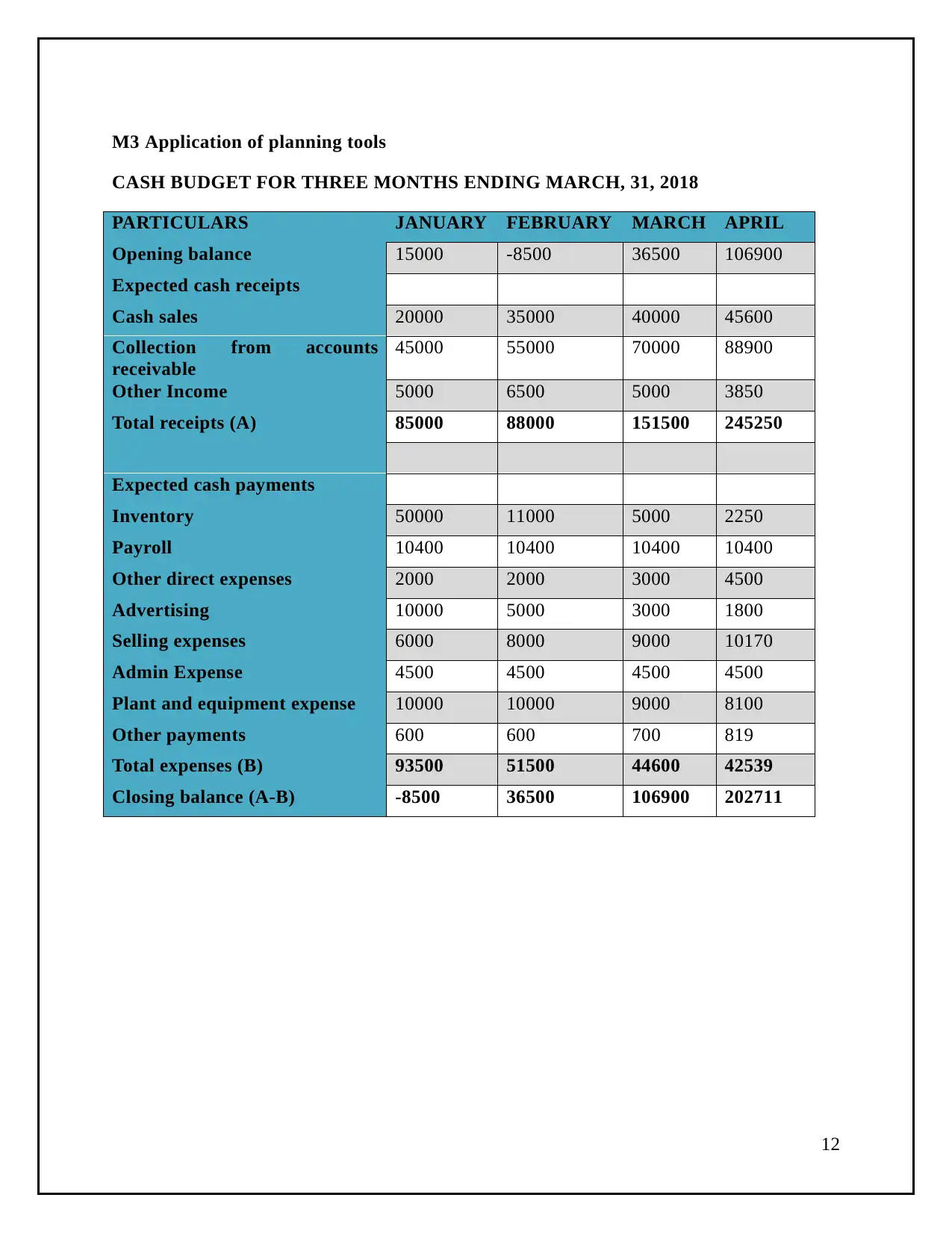
M3 Application of planning tools
CASH BUDGET FOR THREE MONTHS ENDING MARCH, 31, 2018
PARTICULARS JANUARY FEBRUARY MARCH APRIL
Opening balance 15000 -8500 36500 106900
Expected cash receipts
Cash sales 20000 35000 40000 45600
Collection from accounts
receivable
45000 55000 70000 88900
Other Income 5000 6500 5000 3850
Total receipts (A) 85000 88000 151500 245250
Expected cash payments
Inventory 50000 11000 5000 2250
Payroll 10400 10400 10400 10400
Other direct expenses 2000 2000 3000 4500
Advertising 10000 5000 3000 1800
Selling expenses 6000 8000 9000 10170
Admin Expense 4500 4500 4500 4500
Plant and equipment expense 10000 10000 9000 8100
Other payments 600 600 700 819
Total expenses (B) 93500 51500 44600 42539
Closing balance (A-B) -8500 36500 106900 202711
12
CASH BUDGET FOR THREE MONTHS ENDING MARCH, 31, 2018
PARTICULARS JANUARY FEBRUARY MARCH APRIL
Opening balance 15000 -8500 36500 106900
Expected cash receipts
Cash sales 20000 35000 40000 45600
Collection from accounts
receivable
45000 55000 70000 88900
Other Income 5000 6500 5000 3850
Total receipts (A) 85000 88000 151500 245250
Expected cash payments
Inventory 50000 11000 5000 2250
Payroll 10400 10400 10400 10400
Other direct expenses 2000 2000 3000 4500
Advertising 10000 5000 3000 1800
Selling expenses 6000 8000 9000 10170
Admin Expense 4500 4500 4500 4500
Plant and equipment expense 10000 10000 9000 8100
Other payments 600 600 700 819
Total expenses (B) 93500 51500 44600 42539
Closing balance (A-B) -8500 36500 106900 202711
12
⊘ This is a preview!⊘
Do you want full access?
Subscribe today to unlock all pages.

Trusted by 1+ million students worldwide
1 out of 21
Related Documents
Your All-in-One AI-Powered Toolkit for Academic Success.
+13062052269
info@desklib.com
Available 24*7 on WhatsApp / Email
![[object Object]](/_next/static/media/star-bottom.7253800d.svg)
Unlock your academic potential
Copyright © 2020–2025 A2Z Services. All Rights Reserved. Developed and managed by ZUCOL.





